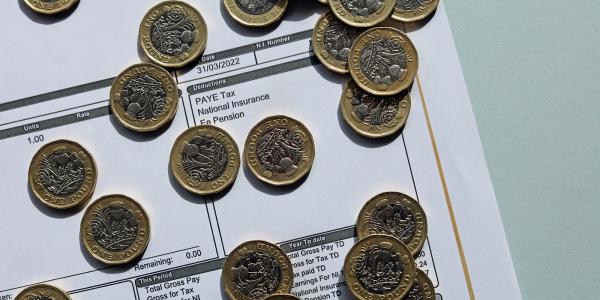NIC for employees
Most employees pay National Insurance contributions (NIC) before they get their wages. On this page, we explain NIC issues that you might come across as an employee.

Content on this page:
Introduction
If you are an employee, you pay class 1 NIC on your earnings from employment, such as your salary and bonuses. The amount you pay depends on how much you earn in a particular pay period, and on your age. See also the heading below: Reaching state pension age.
Employee NIC
If your income from an employment in a pay period is less than the primary threshold for that period, you do not need to pay class 1 NIC on that income. This threshold is aligned with the personal allowance for income tax and is £242 a week or £1,048 a month.
The actual amount of class 1 NIC you pay at the main 8% rate depends on the amount you earn up to the upper earnings limit, which is £967 per week or £4,189 per month for 2024/25.
For 2024/25, the weekly rates of class 1 NIC for employees are as follows:
| On the first £242 | Nil |
| On income between £242 and £967 | 8% |
| On amount above £967 | 2% |
For 2024/25 the monthly rates of class 1 NIC for employees are as follows:
| On the first £1,048 | Nil |
| On income between £1,048 and £4,189 | 8% |
| On amount above £4,189 | 2% |
Class 1 NIC is generally calculated week by week or month by month, depending on whether your employer pays you weekly or monthly. It is not cumulative like income tax deducted under Pay As You Earn (PAYE). This means that the amount of class 1 NIC you pay in one week (or month) is not affected by the amount you have paid in previous weeks (or months) in the tax year.
Employer NIC
Your employer pays a different type of class 1 NIC on your earnings. Sometimes they will show the amounts that they have paid in employer NIC for your information on your payslip – but they should not be deducted from your pay.
You may also come across class 1A and class 1B NIC. You will not pay these contributions as an employee, but you might hear them mentioned, so it is good to know what they are:
- Class 1A NIC is paid by your employer if they provide you with certain benefits-in-kind – for example, a car for private use. The employer pays the NIC on the value of the benefit-in-kind.
- Class 1B NIC is paid by your employer if they enter into a special arrangement with HMRC called a PAYE settlement agreement. This is where your employer pays the income tax due on certain benefits-in-kind and expenses payments.
Earnings below the weekly/monthly thresholds
If you earn less than the lower earnings limit (£123 a week for 2024/25), you pay no class 1 NIC, nor are you treated as paying any NIC, and so you do not get any contributions registered on your NIC record.
If you have earnings above the lower earnings limit (£123 per week or £533 per month for 2024/25) but below the primary threshold (£242 per week or £1,048 per month for 2024/25) you are treated as having paid NICs without actually having to make a payment. Essentially, your NIC record is registered with contributions at nil cost to you.
This type of ‘free’ NIC registered to your record is different from the type of NIC credits that you can sometimes get in certain circumstances, where you are unable to work or have limited ability to work. We discuss these on our page National Insurance credits.
Paying (or being treated as paying) NIC through at least one job can help you qualify for the state pension and certain other contribution-based benefits. You will usually need 35 qualifying years' worth of contributions to get the full amount of the state pension (you should be able to get a pro-rata amount provided you have at least ten qualifying years). You have until you reach state pension age to make those contributions.
You can read more about which benefits depend on your NIC record on our page National Insurance.
Having more than one job
For class 1 NIC, there are separate thresholds available for each job so long as it is with a different employer, unless you are a director of a company (or you work for jobs for the same employer, or associated employers). You can read more about this on our page Multiple Jobs.
NIC deferment
If, in the 2024/25 tax year you have two jobs, and expect to pay class 1 NIC on weekly earnings of at least £967 throughout the whole tax year in one of the jobs, you can ask to defer payment of NIC in the other job. If you are paid monthly, you must expect to pay class 1 NIC on monthly earnings of at least £4,189 throughout the whole tax year in one of the jobs.
You make an application for deferment of class 1 NIC using form CA72A. If you need them there are guidance notes you can download from the same page of GOV.UK.
Employed and self-employed
If you are both employed and self-employed you need to pay:
- class 1 NIC on your employed income; and
- class 4 NIC on your self-employed income.
You will pay your class 1 NIC each pay period. Your class 4 NICs are paid together with your income tax liabilities in your payments on account and balancing payment, via self assessment.
Where someone is both employed and self-employed there is an annual maximum of contributions that is due – there is a link to further information at the end of this page. Therefore, you may not need to pay full class 4 NICs if you have paid sufficient class 1 NIC. You can read more about NIC for the self-employed in our self-employment pages.
Fluctuating pay
Sometimes you see the NIC thresholds given in annual amounts, as well as weekly or monthly amounts. However, you pay class 1 NIC based on the amount you earn in each pay period, whether that is a week or a month. You do not pay class 1 NIC based on your total earnings for the whole year. As mentioned above, it is not cumulative like income tax deducted under Pay As You Earn (PAYE).
If you earn more than the primary threshold (£242 per week or £1,048 per month for 2024/25) in any particular pay period, weekly or monthly, you pay class 1 NIC, even if your annual earnings divided by 52 weeks or 12 months are less than the primary threshold. If your earnings fluctuate, you may find that you pay NIC in some pay periods but not in others.
Look at the following examples to see how this works.
Reduced rate contributions
If you are a woman, who married before 6 April 1977, you could have elected by 12 May 1977 to pay reduced rate class 1 NIC. You can find more information about this on GOV.UK.
Reaching state pension age
If you are an employee, you normally pay class 1 NIC from age 16 until you reach state pension age. You can work out your state pension age using the calculator on GOV.UK.
You can find more information on NIC after state pension age on our separate page.
Further information
HMRC’s detailed technical guidance on NIC, including the annual maximum calculation, is available in HMRC’s NIC Manual.
If you have come from abroad to work in the UK, you can find some information about your NIC position in our International section.
It is rare for employees to have overpaid NIC. There is information on how to claim a refund of NIC in the certain limited circumstances that exist in our main National Insurance page.



